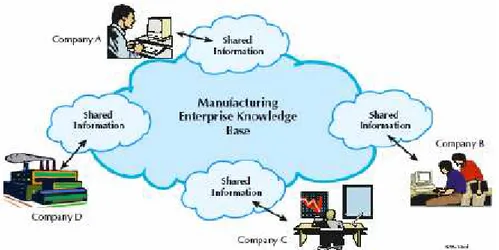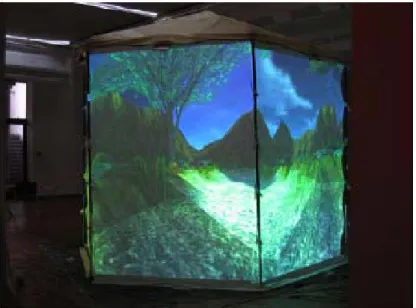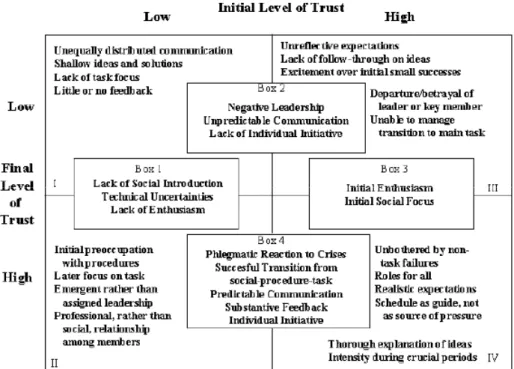Enterprise and Work Innovation Studies, No. 1, 2005 45
Human-Human Collaboration in Virtual Teams
Heinz-H. Erbe (heinz.erbe@tu-berlin.de), Institute of Professional Education, Center of
Human-Machine Systems, Technische Universität Berlin, Germany,
Abstract
Extended and networked enterprises distribute the design of products, planning of the production process, and manufacturing regionally if not globally. Employees are therefore confronted with collaborative work over remote sites. A cost effective collaboration depends highly on the organization maintaining a common understanding for this kind of work and a suitable support with information and communication technology. The usual face to face work is going to be replaced at least partly if not totally by computer mediated collaboration. Creating and maintaining virtual teams is a challenge to work conditions as well as technology. New developments on cost-effective connections are providing not only vision and auditory perception but also haptic perception. Research results for improving remote collaboration are presented. Individual, social and cultural aspects are considered as new requirements on the employees of networked and extended enterprises.
Introduction
Collaboration is working together towards a common goal at different times, in different locations, at different companies in different functions. Principles are: support collaboration within the entire working team including external suppliers and partners, support flexible team participation to minimize collocation as a team requirement, benefiting individuals by making their job easier and helping to achieve work-live balances, providing a collaborative environment, allowing the team to tap into their inherent creativity and power of sharing ideas, focusing on people, process, communication and relationships in addition to technology. This sounds like the intentions of sculpting a learning organization/enterprise as it was presented by Senge (1990) and theoretically developed by Watkins & Marsick (1993). But now the challenge is to extend this theory to globally distributed enterprises. The benefits of collaboration are: reduced problems of resolution cycle time, increasing productivity and agility, reducing travel to remote sites, enabling more timely and effective interactions, faster design iterations, improving resource management and facilitate innovation.
Collaborative work over remote sites in so-called virtual teams is therefore a challenge to developers of information- and communication technology as well as to the involved workforce. Collaboration demands a deep involvement and commitment in a common design, production-process or service; i.e. to work jointly with others on a project, on parts or systems of parts (Acosta & Moreno, 2005; Erbe, 2005). Information mediated only via vision and sound is insufficient for collaboration. In designing and manufacturing it is often desirable and in maintenance it is necessary to have the parts in your hands. To grasp a part at a remote site requires force (haptic)-feedback in addition to vision and sound.
Technological aspects
Fig. 1. Remote distributed factory sites (© Center for e-design, Univ. of Pittsburgh).
Centers for e-design got established at different universities, just to name Pittsburgh University together with the University of Massachusetts, Amherst (Nnaji, 2004), among others. The communication is mostly done with data-transfer using distributed CAE-systems like CATIA, i.e. a visual access to the products under the design process. The designers have to negotiate a shared understanding (Fig. 1). Figure 2 defines levels of collaboration.
Fig. 2. Levels of Information System Inter-operability (Mc Quay, 2003).
This is done partly through video conferences. But in the camera-monitor mediated world of videoconferencing, the limitations of communications bandwidth and equipment capability tend to place a severe handicap on the senses of sight and sound and eliminate the sense of touch (Xu & Cooperstock, 1999). As a result, even in state of the art videoconference rooms using the highest quality equipment, the sense of co-presence enjoyed by individuals in the same room is never fully achieved. "Gaze awareness, recognition of facial gestures, social cues through peripheral or background awareness, and sound spatialization through binaural audio, all important characteristics of multiparty interaction, are often lost in a videoconference", as Xu & Cooperstock put it.
Enterprise and Work Innovation Studies, No. 1, 2005 47
development is not focused to distributed design and manufacturing but to tele-medicine and training, a haptic feedback would help bridging the physical separation of remote individuals. This feedback should range from reproducing the floor vibrations in response to a user walking about to the tactile response of a surgeon's instrument as it moves through different tissue.
Fig. 3. Simple CAVE generated with canvases fastened on hexagonal scaffolding
Bruns & Yo (2004) and their group developed simple computer animated virtual environments (CAVE) that generates a feeling of immersion in a virtual world without headsets or other special devices. Canvases are fastened on hexagonal scaffolding, and computer controlled video-projectors beam a landscape onto the canvases (Fig. 3). Inside the cave one can walk through the landscape while touching sensors when walking. The sensors control the projectors. Figure 4 shows a possible application for virtual team working.
Fig. 4. Example of a simple CAVE for virtual team work
developments are first approaches to create virtual work spaces generating a feeling of immersion in a virtual team. See also Kheddar & Buss (2004) for the state of the art of haptic devices.
Fig. 5. Model of tele- cooperation with force feedback.
Individual, social and cultural aspect
Enterprises investing in the new information and communication infrastructures have to consider the important issues to develop a culture and shared values that can facilitate the adoption of such technologies (Fig. 6).
Fig. 6. Socio-technical issues (Mc Quay, 2003)
Investment in advanced technologies may not necessarily result in improved communication by and between the employees. Often managers and the developers of IC - technology assume too much about the anticipated use of the technology by the employees. For most employees, collaborating in a virtual mode via mediating technologies may be totally new and may cause anxieties. The loss of human contact could be balanced by maintaining continuous communication as well as by holding occasional face-to-face meetings for information sharing and support. One has to consider People, Process and Technology (Fig. 7):
Enterprise and Work Innovation Studies, No. 1, 2005 49
Fig. 7. The triangle of People, Process and Technology (Mc Quay, 2003)
To extend their product development and the manufacturing globally, enterprises face increasing time compression, when using foreign based subcontracting labor. Global teams promise the flexibility, responsiveness, lower costs, and improved resource utilization necessary to meet ever-changing task requirements in highly turbulent and dynamic global business environments.
While the promises are laudable, a dark side to the new form also exists: such dysfunctions as low individual commitment, role overload, role ambiguity, absenteeism, and social loafing may be exaggerated in a virtual context. Moreover, customers might perceive a lack of permanency, reliability, and consistency in virtual forms. The question is whether virtual teams can function effectively in the absence of frequent face-to-face interaction.
Trust between the actors of virtual teams has been identified as a prerequisite for an effective collaboration cross-border of companies, countries and cultures. "Trust needs touch" (Handy, 1995). “However, paradox enough, only trust can prevent the geographical and organizational distances of global team members from becoming psychological distances. Trust allows people to take part in risky activities that they cannot control or monitor and yet where they may be disappointed by the actions of others” (cited from Jarvenpaa & Leidner, 2000). In their case studies these authors questioned: Can trust exist in global virtual teams where the team members do not share any past, nor have any expectation of future, interaction? How might trust be developed in such teams? What communication behaviors may facilitate the development of trust? The global virtual teams had members who
(1) were physically located in different countries,
(2) interacted through the use of computer-mediated communication technologies (electronic mail, chat rooms, etc.), and
(3) had no prior history of working together.
A global virtual team was defined to be a temporary, culturally diverse, geographically dispersed, electronically communicating work group. The notion of temporary in the definition describes teams where members may have never worked together before and who may not expect to work together again as a group. The characterization of virtual teams as global implies culturally diverse and globally spanning members that can think and act in concert with the diversity of the global environment. Finally, it is a heavy reliance on computer-mediated communication technology that allows members separated by time and space to engage in collaborative work.
Some practical implications can be drawn from the studies. For the manager of a virtual team, one of the factors that might contribute to smooth coordination early in the existence of the team is a clear definition of responsibilities, as a lack of clarity may lead to confusion, frustration, and disincentive.
For the participants on virtual teams, there are some observations derived from the study which may be relevant to practice. Although it is not necessarily critical to meet in person, it is critical to engage in an open and thoughtful exchange of messages at the beginning of the team's existence. Cavalier attitudes that the virtual environment is no more challenging than a face-to-face environment prove to have ephemeral effects on participant enthusiasm and, once difficulties arise, the team lacks a substantive foundation upon which to overcome the real challenges imposed by the virtual context.
Participants should also have an awareness of the importance of their providing to the others timely and detailed accounts of the work they are doing. Likewise, participants must be aware of the need to provide thorough feedback on the contributions of the other members. Finally, participants should be aware that it is not the quantity, but the quality and predictability, of their communication that is most critical to the effective functioning of the team. The research of Jarvenpaa & Leidner (2000) suggests that trust can exist in teams built purely on electronic networks. The study describes a number of communication behaviors and member actions that distinguished global virtual teams with high trust from global virtual teams with low trust (Fig. 8). Encouraging such behaviors and actions on the part of members of global virtual teams might help to foster a climate conducive to the existence of trust.
Fig. 8. Matrix of Low and High Level of trust in collaborative work (Jarvenpaa & Leidner, 2000)
Conclusion
Enterprise and Work Innovation Studies, No. 1, 2005 51
(1) Greater work complexity;
(2) More limitations caused by increasing inter-dependence; (3) Issues of integrity and trust;
(4) Greater need for coordination, cooperation, and synchronization;
(5) Communication challenges and failures, complicating systems’ requirements; (6) Problems of mismatch, e.g., inconsistent versions, cultural differences, etc.; (7) New users training requirements and associated costs.
Failing to overcome these common challenges may explain why often, e-activities do not fulfill the expectation promised by technology”. These problems have to be solved in future research and development. Recent results of research projects on and tele-cooperation and future work spaces (EU-project on Future Workspaces (2002/2003) promise a suitable support for the involved workforce if further developed. This could help to make virtual team work effective by avoiding misinterpretation and therefore reducing the time-to-market, one of the drives for a global production.
References
Acosta, C. & Moreno, E. (2005) “Distributed Engineering Teams and their organizational Aspects” In Proc. 16thIFAC World Congress, Elsevier Ltd, Oxford.
Erbe, H.-H. (2005) “Learning for an Agile Manufacturing” In G.Zülch, H.S.Jagdev and P.Stock (Eds.) Integrating Human Aspects in Production Management (pp. 269-279) Springer Verlag, Berlin.
Handy, C. (1995) “Trust and the virtual organization”, Harvard Business Review, 73 (3), 40-50.
Jarvenpaa & Leidner, 2000 “Communication and Trust in Global Virtual Teams”, Report, Graduate School of Business, The University of Texas at Austin.
Kheddar, A. & Buss, M. (2004) “Touch and Haptics” IROS 2004, International Conference on Intelligent Robots and Systems (http://www.touch-hapsys.org)
Mc Quay, B. (2003) “Distributed Environments Technology for e-design”, Report, Air Force Research Laboratory, Wright-Patterson AFB OH, AFRL/IFSD
Nnaji, B., Wang, Y. & Kim,K.Y. (2005) “Cost effective Product Realization” In Proceedings 7th IFAC
Symposium on Cost Oriented Automation. Elsevier Ltd., Oxford.
Nof, S. (2004) “Collaborative e-Work and e-Mfg.: The state of the art and challenges for production and logistics managers” In Preprints of the 11th IFAC Symposium on Information Control Problems in
Manufacturing – INCOM 2004. Elsevier Ltd., Oxford.
Nohria, N., & Eccles, R. G. (1992) “Face-to-face: Making network organizations work” In N. Nohria and R.G. Eccles (Eds.), Networks and organizations (pp. 288-308). Boston, MA: Harvard Business School Press.
Senge, P. (1990) The Fifth Discipline, Doubleday, New York.
Watkins, Karen E., Marsick, Victoria J. (1993) Sculpting the learning organization, San Francisco: Jossey-Bass Publishers.
Xu A., J. Cooperstock (1999) CIM, McGill University, Montreal



